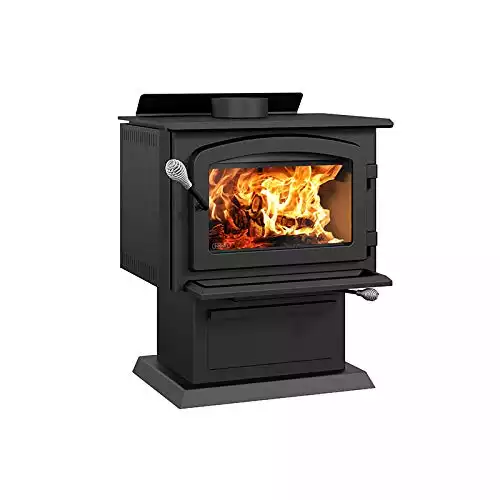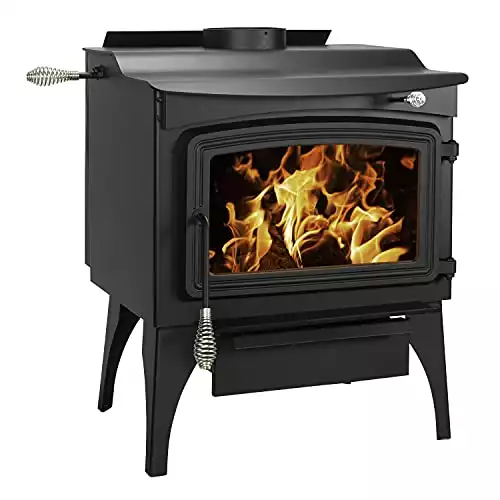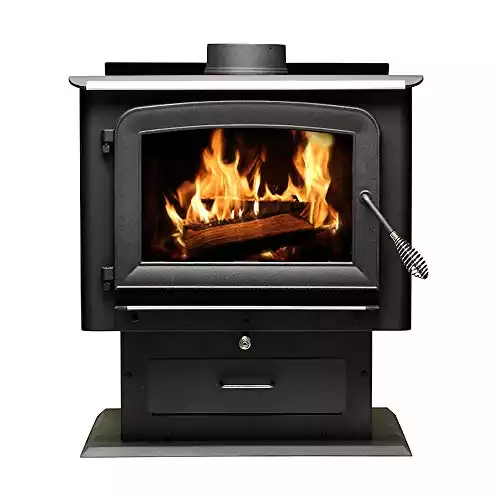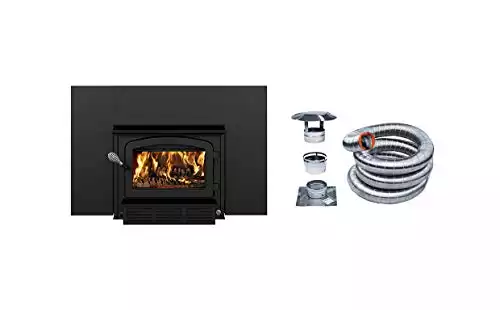Wood stoves have been in the market for a very long time, since the 1500s. They have been used to heat homes all over the world for decades. Today’s wood stoves have evolved and have improved safety and efficiency.
They produce almost no smoke, use less firewood, and have minimal ash. In the U.S, these stoves are found in areas that experience cold winters. However, there are many types of wood stoves, and it may be confusing for any buyer. You may be wondering if you need a small, medium, or large stove. Also, what is the difference between a fireplace insert and a free-standing stove?
What stove size should you buy for your property? The process is not as easy as choosing the stove that is currently on sale. However, the good news is that we are here to help you out. We have put together a detailed guide on how to choose the best wood stove. Read on to find out;
At a Glance: Best Wood Stove
|
Primary Rating:
3.5
|
Primary Rating:
3.5
|
Primary Rating:
3.5
|
Primary Rating:
3.5
|
|
N/A
|
N/A
|
$1,024.93
|
N/A
|
What Is A Wood Stove?
A wood stove is a home appliance that is used to heat the home. It is made of metal such as steel or cast iron and usually generates heat by burning wood fuel in an enclosed fire chamber. It consists of a stove, chimney, damper, and baffle. When you light a fire in the wood-burning stove, heat from the fire warms the air in the room, and smoke is drawn out through the chimney.
The work of the damper is to control airflow to the stove, hence affecting the size of the fire and heat produced. Baffles increase the combustion time of the fire gasses, as partially combusted gasses are air pollutants. These wood stoves can be placed in many areas, as long as there is means to allow fumes and gases to be drawn away.
Emission Limits For Wood Stoves
The Environmental Protection Agency (EPA) 2020 Guidelines require that all wood burning products should produce less than 2.5g/hr in particulate matter. In the 2015 New Source Performance Standards (NSPS), the guidelines required were less than 4.5g/hr. Therefore, the amount of particulate matter released has been reduced in today’s wood stoves to conserve the environment and reduce health issues caused by air pollution.
Since 2020, stove manufacturers have improved their combustion technologies; hence they have a lower g/h rating, meaning a cleaner and more efficient wood stove. Therefore, when buying a wood stove, ensure that it is EPA-certified, meaning that it meets the EPA clean air standards. It will also produce less smoke and require less wood to work.
Types Of Wood Stoves
There are two main types of wood stoves: catalytic and non-catalytic. The main similarity between them is that they both meet EPA standards, with the differences being in their heat output and maintenance levels.
Catalytic

These stoves have a ceramic honeycomb-shaped component that burns the gases and particles from the wood inside the stove. They burn pollutants from the fire, hence creating more heat and fewer emissions. Moreover, their efficiency and capability to produce a long and even output give them an added advantage.
However, these stoves need regular maintenance as the catalytic combustion component must be inspected regularly. Ensure that you clean the catalytic combustor plate once per week or twice, especially during the cold season. If well maintained, it can last up to six seasons. However, if the wrong fuel is used, the stove is over-fired and regular cleaning not done, the catalyst stove can break down in 2 years or less.
Non-catalytic
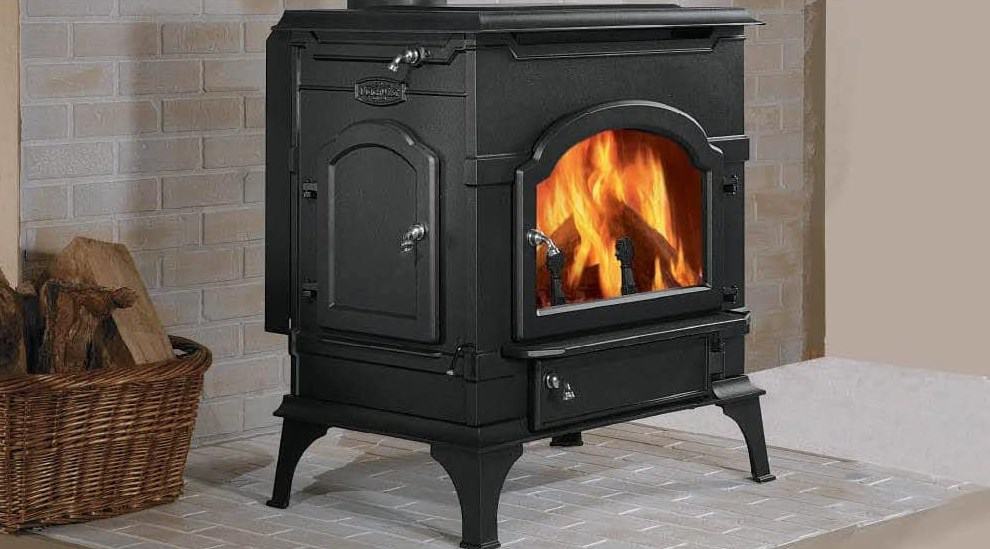
As the name suggests, these stoves do not use a catalyst, but they have three key features fostering combustion. These include pre-heated combustion air, firebox insulation, and a large baffle to produce a massive hot gas flow path.
Non-catalytic stoves are cheaper and require less maintenance than catalytic wood stoves. They do not have a catalytic combustor plate but still meet the EPA certification requirements.
The Types Of Wood To Burn
All wood burns, but not all wood burns the same. Also, not all wood should be burned on this stove. They all burn differently, with some burning slower, hotter, and cleaner than others. Others produce lots of smoke, and others have lots of resin that will clog your chimney. For wood stoves, the best wood to use is hardwood as they produce more heat, burn more thoroughly, and are more steady. Softwoods, on the other hand, such as pine and spruce, are messy to handle, burn faster and cause creosote to build up in your chimney. The best woods include:
- Oak- its density produces a small flame and slow burn. It is pretty popular as it is highly available. The only drawback is that it needs a long seasoning time, generally 18 months.
- Ash-it is considered one of the best woods for burning as it produces a steady flame and strong heat output. It is also relatively easy to split and has a low smoke point.
- Beech- it burns pretty similar to ash.
- Apple- it burns slowly while producing an appealing scent. It also has a shorter seasoning time than most hardwoods.
- Robinia-it has a slow burn and strong heat output. It produces acrid smoke, but it will not be an issue when used in wood stoves.
- Birch- it produces a strong heat output.
- Horse chestnut- it produces a good flame and strong heat output.
- Thorn-it is excellent as it does not produce excess smoke and has a strong heat output.
Comparing wood by their heat energy
Different woods produce different amounts of heat. The best firewoods offer the heat equivalent of 200-250 gallons of fuel. These include:
- Apple.
- Birch.
- Beech.
- Hickory.
- White ash.
- White oak.
- Red oak.
- Maple.
Others offer an equivalent of 150-200 fuel gallons per firewood cord. They include:
- Tamarack.
- Elm.
- Birch.
- Cherry.
- Douglas fir.
The last category produces the least heat, about 100-150 gallons of fuel oil. They are:
- Aspen.
- Cedar.
- Cottonwood.
- Alder.
- Pine.
- Spruce.
- Redwood.
Benefits Of Wood Stoves
Wood stoves have numerous benefits. These include:
They are energy efficient
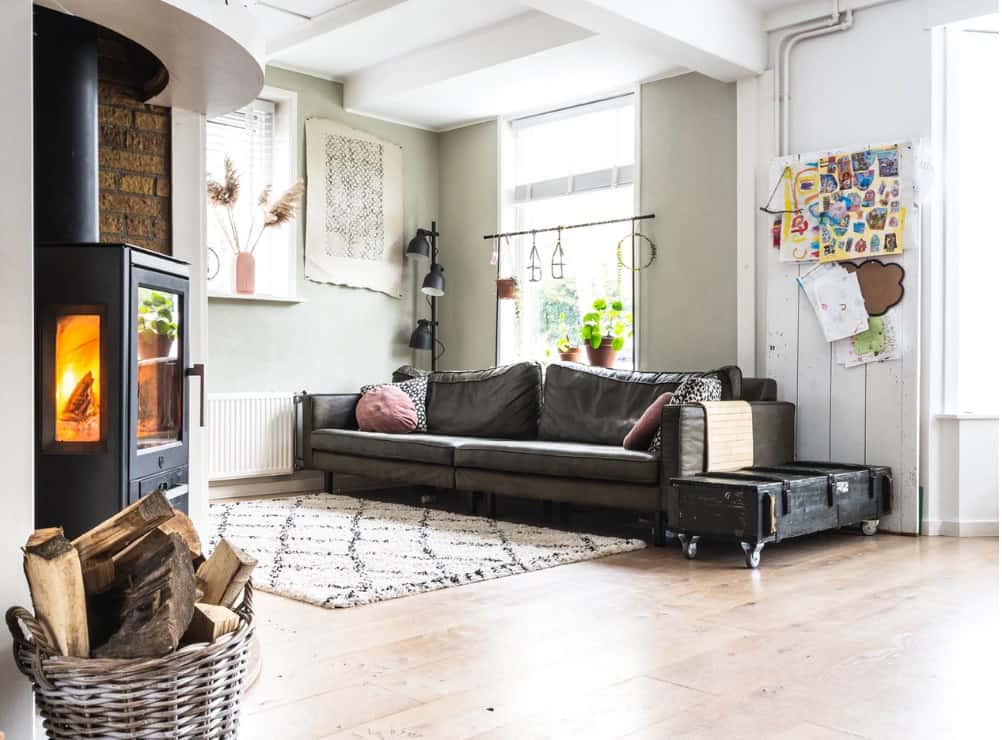
Wood stoves are energy efficient in that, while an open fireplace has around 25% efficiency, a wood stove is 80% efficient. The wood used here is also cheaper than electricity, oil, and gas. A wood stove can produce a kWh at a third the cost of a kWh of oil and a fifth a kWh of electricity cost.
They are reliable
Over the past few years, winter weather has become quite unpredictable. There has been a loss of power experienced due to flooding, bad weather, and freezing. Hence, winter heating will not work during a power outage. Here is where a wood burner comes in. It is reliable as it does not need gas, oil, or electric power to function. Therefore, a power cut cannot affect it, and it will ensure that the home stays warm regardless.
They are great for the environment
When compared to other fossil fuels such as propane, coal, and natural gas, wood is more eco-friendly. It is carbon-neutral, meaning that it does not add carbon dioxide to the environment when it burns. Before it was wood, it was a tree in its natural state, absorbing carbon dioxide in the atmosphere. Therefore, during combustion, a balance is maintained.
They are flexible
Wood stoves can be placed anywhere in the home, as long as a vent pipe goes outside the home. You can, therefore, zone-heat different rooms of the house.
Effective heat output
Wood stoves operate on radiant heat; hence they warm the area faster and more effectively than the vent system. This heat radiates from the top and all sides, thus sending heat in all directions.
They are economical
Wood is inexpensive and costs less per BTU than electricity, gas, or oil. These non-renewable resources, such as coal, oil, or propane, are surging in price due to increased demand and diminishing resources. Therefore, you can save hundreds of dollars in a year in utility bills if you use strategic zone heating in your home. You can also save lots of money by buying an EPA-certified stove as it will use less fuel and burn more efficiently.
They have a cooking convenience
Did you know that you can use your wood stove for cooking? Yes, you can! It is one of the most overlooked benefits of wood stoves. Some models double as a stovetop, and all you need to do is add some cookware and adjust the temperature, and you will be good to go.
They are decorative
In addition to providing heat to the home, wood stoves can also compliment your décor. They will become your new focal point and add style and character to your home. They come in various styles, from classic to contemporary; hence, you have many options to choose from.
Wood Stove Buying Guide
There are different sizes, models, and styles of wood stoves to choose from. Below are factors to consider:
Choose The Right Size
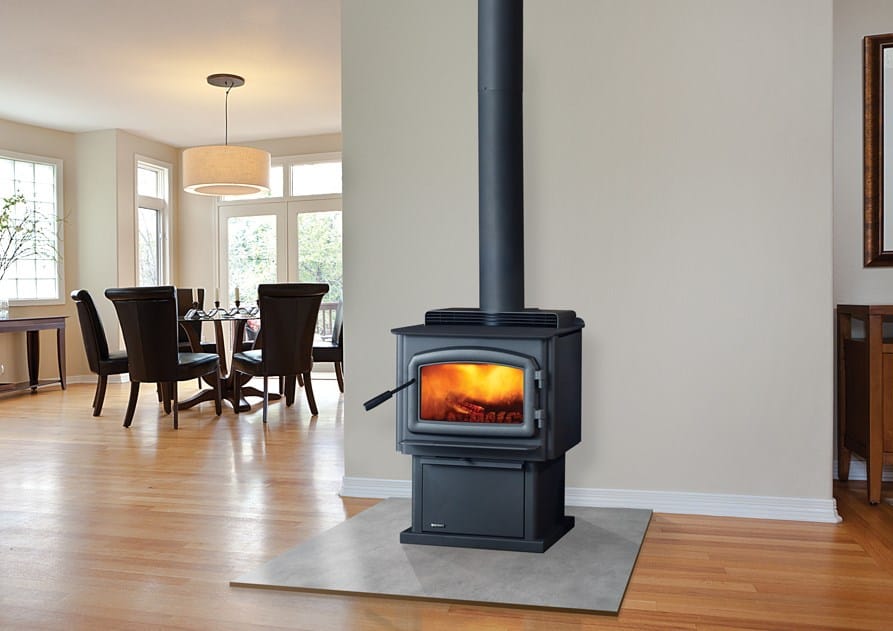
This is one of the first things that you should consider. What size do you need? Will you use the wood stove to heat the home or for enjoyment? If you are going to use it for heating, you need to consider the size of the area to be heated.
Small stoves are perfect for heating small family rooms or seasonal cottages. You can also use a small stove for zone heating in specific areas of large houses. This will help reduce fuel consumption, save money, and also conserve energy. Medium stoves are suitable for small and medium-sized homes and also cottages used in winter. Large stoves, on the other hand, are more suited for massive and older houses.
Most people tend to go for the biggest stove they get as first-time buyers, yet this should not be the case. As a general rule, a modern stove can heat 10m2 per kW. When heating a space of around 1500 square feet, the firebox will be between 1.5-2 cubic feet, with a maximum heat output of 50,000 BTU/hr. For a larger space, up to 2500 square feet, the firebox should be between 2-2.5 cubic feet, with 70,000 BTU/hr.
Chimney
When using a wood stove, you need a functioning chimney. Therefore, before buying one, look for a certified chimney service provider to check if your chimney can be used for your new wood stove.
If the chimney passes the test, you will need to choose a wood stove to work with it efficiently. Also, using your home’s chimney will save you more money than buying a new one, which will be more expensive and take more time. However, if your home did not have an existing chimney, you might need to install a new one. When doing so, check to ensure that it is tight and has a correct draught.
Efficiency
Efficiency is crucial, as the higher it is, the less the money and time spent on chopping and hauling wood. Older wood stoves are less efficient than the newer models. Therefore, look for the more recent models, as they are more efficient and save you trips to the woodpile in winter.
Design
There are many designs to choose from, and this depends on your tastes and preference. They include round, side glass, soapstone, square, turntable baser, and several colors to choose from. You can choose from the various color combinations, handles, and heights to decide what you would like for your home.
Location
The location of the woodstove is another crucial factor that you should consider. There are three factors to consider:
- The weight that the floor can tolerate. Ensure that the base is stable and can bear the weight of the stove.
- The distance to the flammable materials. According to the National Fire Protection association, wood stoves should be placed at a safe distance from combustible materials such as wood. However, if you have a brick, tile, or stone wall, there is no minimum requirement.
- Should the wood stove have a top or back outlet to the chimney? This will determine where you place it.
Freestanding Stove Or Fireplace Insert
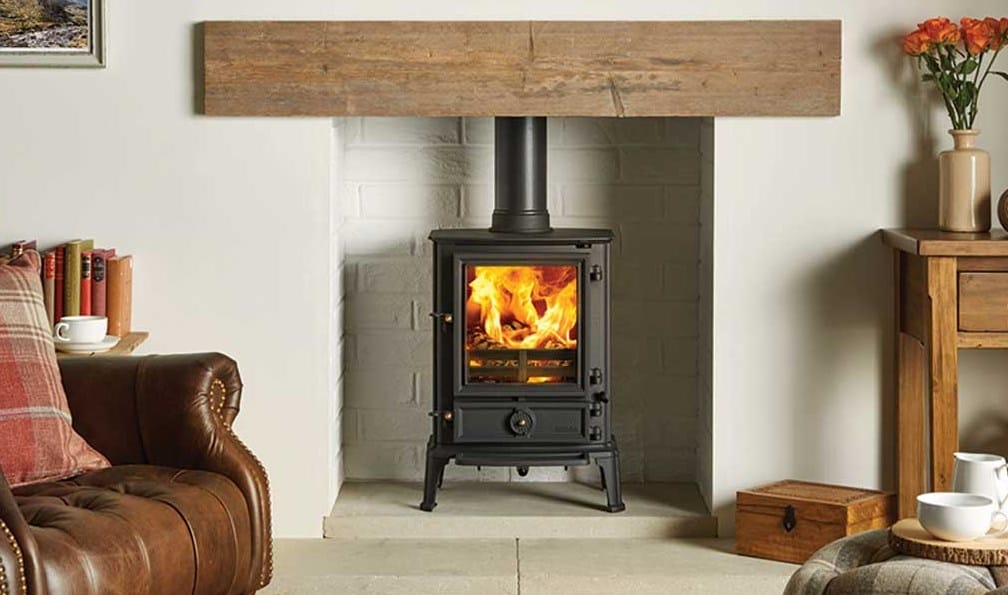
Free-standing stoves are usually installed in places without pre-existing fireplaces, such as tiles or brick floors. They come in many configurations, such as those elevated on towers or pedestals or low to the floor. Fireplace inserts are great for integrating a wood heater into a fireplace. Inserts work like the free-standing stove, except that they must be located within the existing fireplace. A free-standing stove is more flexible with its location, and it does not have to be placed in your fireplace.
Certified Stores
You may have the best wood stove in mind, but you will end up in premium tears if you buy from an uncertified store. This is because you will get a low-quality stove that will break down in a few months. For high-quality wood stoves, buy from an EPA-approved store, as it will ensure that you purchase modern stoves that are highly efficient and use less firewood. You will also have peace of mind knowing that you have an efficient system.
Catalytic And Non-Catalytic
When introduced in the 1980s, catalytic stoves had a bad reputation due to their poor designs and fouled catalytic combustors damaged after a few seasons.
However, the new catalytic wood stoves in the market are improved and more efficient. They are cleaner and better than their non-catalytic counterparts. However, catalytic are more expensive and require more maintenance. Therefore, it is up to you to decide whether to choose the cleaner and more expensive version or the non-catalytic stove.
The Type Of Wood
Burning the right type of wood is as essential as choosing the best wood stove for you. All woods in your house should be adequately dried and seasoned before use. If done so, you will get to experience the hottest and cleanest fires with minimal creosote buildup, which is a huge cause of many chimney fires.
Wood must be set to dry and season for at least a year before it is burned. Also, the best burning conditions are usually achieved after two to three years of seasoning. So, this means that by now, you should already have split your wood in readiness for next year’s burning and stored them in a dry shed.
Have A Qualified Installer
You cannot install a wood stove by yourself, no matter how many DIY videos you watch. It is not recommended to do so as you are not experienced in the subject and may get horrible results. Unless you have experience with the local fire codes and interior and exterior home remodeling, please do not install it yourself. Hire an experienced and certified installer to help you with the installation.
How To Light A Wood Stove

There are several steps that you should follow when lighting a wood stove. You will need an old newspaper or plain paper and some dry kindling. The steps include:
Prepare the stove
Clear out any excess ashes from previous fires. Ensure around one inch of ash is at the stove’s bed to help improve its efficiency and insulate the fire.
Make a fire bed
Place the firelighters or paper and dry kindling wood in a crisscross arrangement on the fire bed. To have a successful fire, ensure that you have sufficient kindling. The crunched papers should not be tightened, and do not pack them too tightly into the stove as they need adequate air.
Warm The Flue
Ensure that the flue above the wood stove is not too cold for the fire to burn. If it is too cold, then you can try some tricks to get it going. These include leaving the stove door open for some time before lighting the fire to bring both the flue and stove to room temperature.
Cold flue can prevent fire from staying on for a long time as it will prevent waste gases and smoke from leaving. You can also hold a heat source below the flue outlet to start the draft. If smoke rises into the flue, it is a sign that there is enough draft on the stove to light the fire.
Light The Fire
Before you light the fire, ensure that all the air vents are fully open. Since the perfect conditions are set, meaning that the fire is built and flue warm, it is time to light the fire. Here, burn the papers at different points to help spread the fire to the kindling quickly. Once the wood has caught fire, you can close the door of the woodstove, leaving the air vents open.
Leave The Door Partially Open.
Do not leave the door fully open once the fire is burning as the airflow into the stove cannot be controlled. However, leaving it partially open will help the flue pull and help light the fire. It also ensures that there is no condensation buildup on the glass.
Add Larger Pieces
Once the fire is burning well, you can add larger pieces gradually. Do not add them immediately as you will smother the fire and lead to over firing.
Keep Monitoring The Airflow
Once the fire is burning adequately, you can now monitor the airflow to prevent it from burning too fast. Different wood stoves have several ways to adjust their airflow.
Our Top Wood Stove Picks
Drolet Blackcomb II Wood Stove
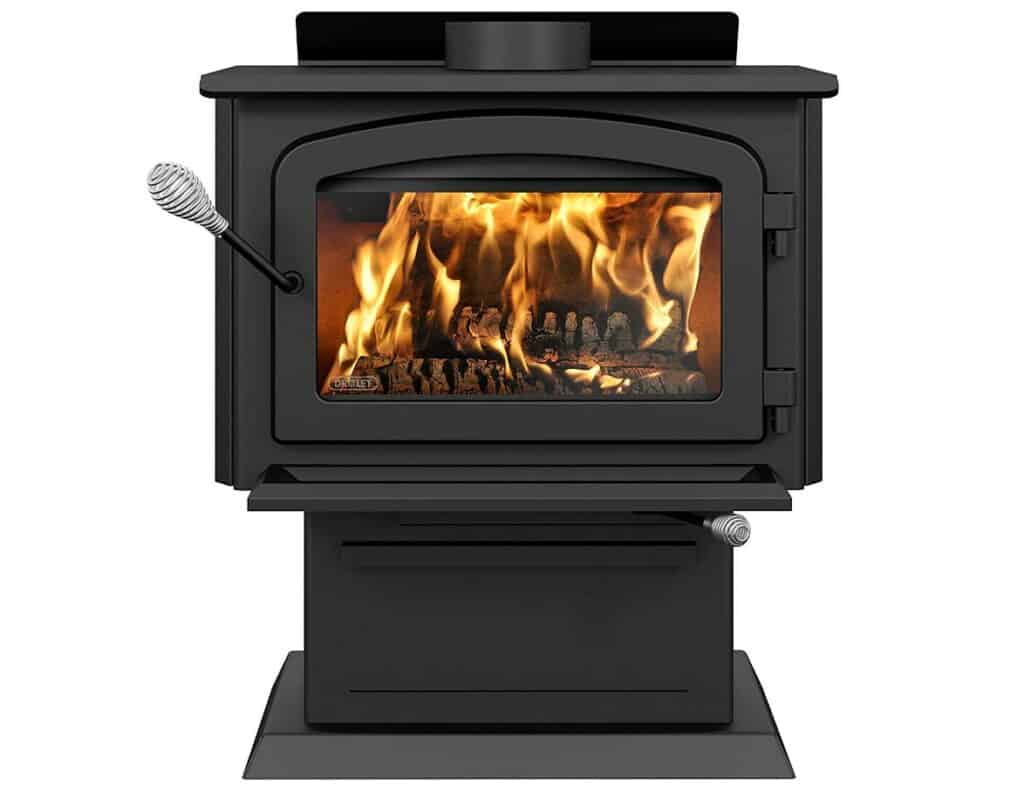
This Drolet Blackcomb wood stove puts out a heat output of 65,000 BTU/h to warm an 1800 square feet room. It, therefore, is big enough to accommodate many homes. It wins our hearts as the most efficient wood stove in the market currently. No other wood stove comes close and remarkably performs like this one. Drolet is considered to be the best wood stove manufacturer; hence you know that you are in the right hands.
It has a +70% efficiency; thus, it has a meager smoke emission rate of 1.26g/h, hence being a 2020 EPA-certified wood stove. It also has a long burn time of 6 hours, while average wood stoves burn for only 4 hours. This means that you can load it and leave it on overnight. The only drawback with this stove is that it has a limited capacity for 2000+ sq ft homes.
The Blackcomb II wood stove is ideal for heating spaces up to 1,800 ft² with a maximum heat output of 65,000 BTU/h. EPA certified at 1.26 g/h, this non-catalytic unit represents an eco-responsible heating source.
Pleasant Hearth 1800 Square Feet Wood Stove
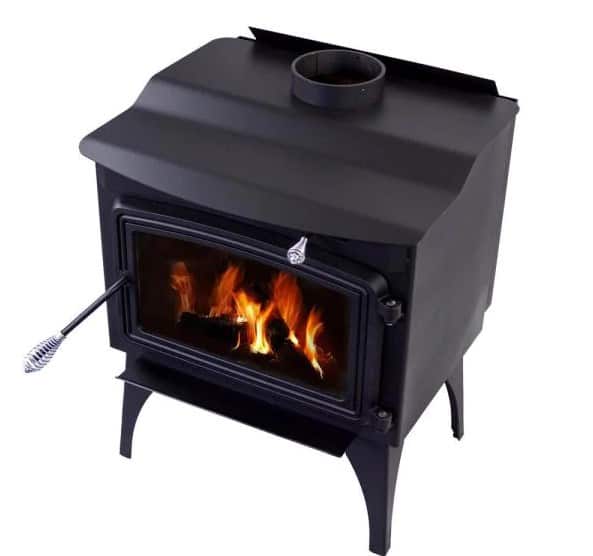
If you want a highly efficient wood stove with a large glass window, this is the type for you. It has a front loading cast iron door and a brick-lined firebox. However, it cannot be used in vast spaces. It is also 2020 EPA certified, OMNI tested, and has 2.18g/h emissions. Clean-up with this stove is seamless, as the ash door is located at the bottom of the furnace.
Pleasant Hearth non-catalytic wood-burning stoves will warm your home with highly effective and efficient zone heating. This woodstove will heat up to 1,800 sq. ft. with 62,789 BTUs of heat from the oldest sustainable resource, wood.
Ashley Hearth Wood Stove
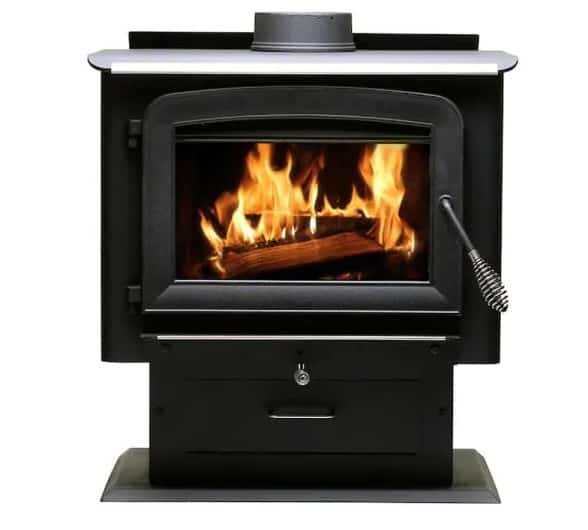
One of the misconceptions people in large homes have is that they will not find a perfect wood stove for their house. What if we told you that we have the ideal match for your massive residence? In the past, no wood stove could produce more than 50,000BTU/h, but times have changed. With this Ashley Hearth wood stove, you can get up to 152,000 BTU output. It is the best large home wood stove in the market and can accommodate all the people in your house. It is a powerhouse that can deliver even if you have a 3000 sq foot home or bigger.
This Ashley Hearth AW3200E-P has a 3/16 inch steel gauge plate that helps prolong its lifespan and increase its burning efficiency. It has an adjustable speed blower that can achieve up to 100CFM to distribute heat evenly throughout the house. It also weighs less than the Drolet Blackcomb II.
The only drawback is that we do not have any information on the burn time, emission rates, and efficiency percentage. This is yet to be known.
Help provide your home with warmth and comfort with the Ashley Hearth Products AW2520E-P 2,500 sq. ft. large size plate steel wood stove. The AW2520E-P wood stove accepts logs up to 21 inches which reduces time spent filling the stove for long burn times.
Drolet Escape 1500-I
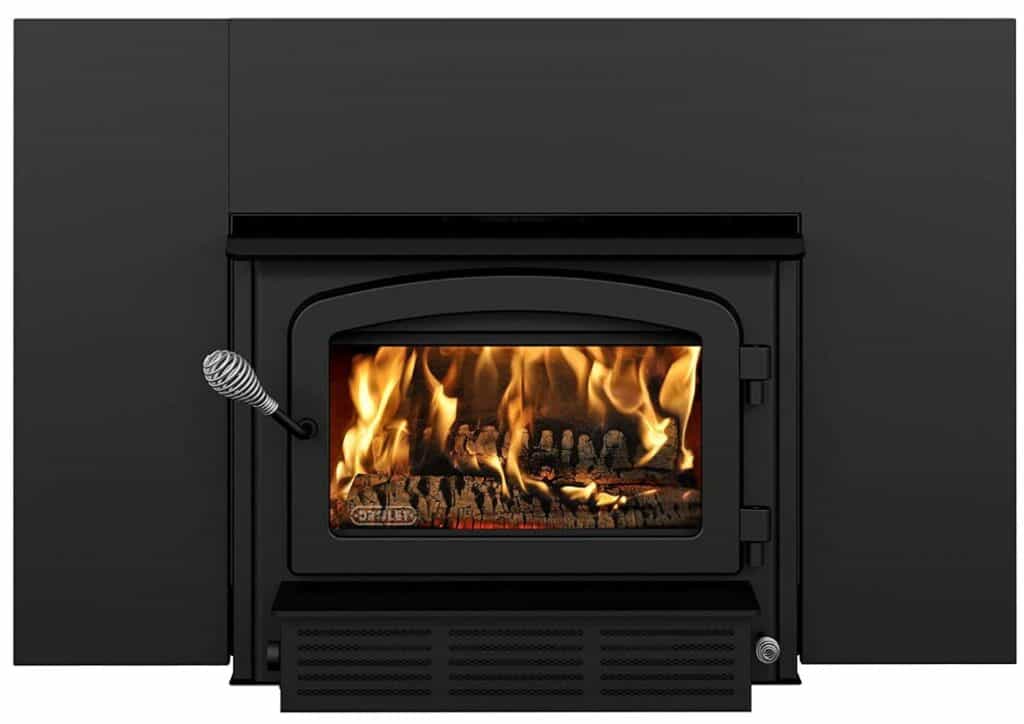
One of the most eco-friendly wood stoves in the market is the Drolet Escape 1500-I. It is highly efficient and effortless to install. It has a 55,000BTU/h output and can heat up to 1800 sq ft rooms. However, it is recommended to be used in 500-1200 sq ft houses. It has an efficiency of 78%, making it the most efficient wood stove, as it saves a lot of wood. It also has low emission rates of 1.26g/h and a longer burn time. Therefore, if you are looking for a highly efficient and eco-friendly wood stove, then you can never go wrong with this one.
Combining performance and respect for the environment, the Escape 1500 is the perfect choice for heating homes up to 1,800 ft². The Escape 1500 is the perfect way to update your masonry fireplace, and make it efficient!
FAQs
Question: Can You Have A Wood Burning Stove Without A Chimney?
Answer: Yes. Instead, you can use a twin wall flue system to enjoy the benefits of a wood stove without a chimney. It is a series of connectable stainless steel pipes that help carry fumes outside the house. They have a stainless steel pipe wrapped in thick insulation and covered by a second outer tube.
This keeps the temperature warm enough to allow the fumes to draw through the pipe and go outside. These twin wall flue systems can either be installed internally or externally. In the former, you will run the flue through the inside of the house and out of the roof. You will connect the pipe to the stove and let it exit through an external wall in the latter.
Question: Will A Wood Stove Heat The Whole House?
Answer: Wood stoves are not designed to heat the whole house, but only a specific area such as the kitchen. However, modern wood stoves are more advanced, and most of them can heat the entire home. There are also massive wood stoves that produce more than 100,000 BTU/h that is more than enough to heat a whole house. Also, if you have a back boiler, the wood stove will heat the entire property efficiently and with no problems.
Question: How Do I Empty Ashes?
Answer: Most people clean out the ashes too quickly, which is not recommended. It is advised to leave a layer of ashes at the bottom of the fireplace as it helps insulate and protect the floor from heat.
Question: How Long Do Wood Stoves Last?
Answer: Wood stoves last anywhere between 10-20 years. The cheaper ones last around ten years and have a lower weight-to-BTU ratio. The more expensive types last closer to 20 years if properly maintained.
Conclusion
As seen above, there are numerous wood stoves in the market. However, with this comprehensive guide, you will be better placed to choose the one that suits your needs best and keeps you warm during winter. It is also crucial to note that you should hire a professional to help you and ensure that the installation is done well.
Remember that your safety is critical, and the more reason you need a professional chimney company to help you. Once it is installed, you can now enjoy your hot cup of coffee and the fire as it viciously burns.
|
Primary Rating:
3.5
|
Primary Rating:
3.5
|
Primary Rating:
3.5
|
Primary Rating:
3.5
|
|
N/A
|
N/A
|
$1,024.93
|
N/A
|
Continue reading related wood stove guides and reviews.
- The Best 2.5 Ton Heat Pump Guide: Which is Right for You? - December 9, 2023
- Furnace Flame Sensor Replacement Guide 101: How To Replace Your Furnace Flame Sensor - May 6, 2022
- The Best 6000 BTU Mini Split Options - May 5, 2022

